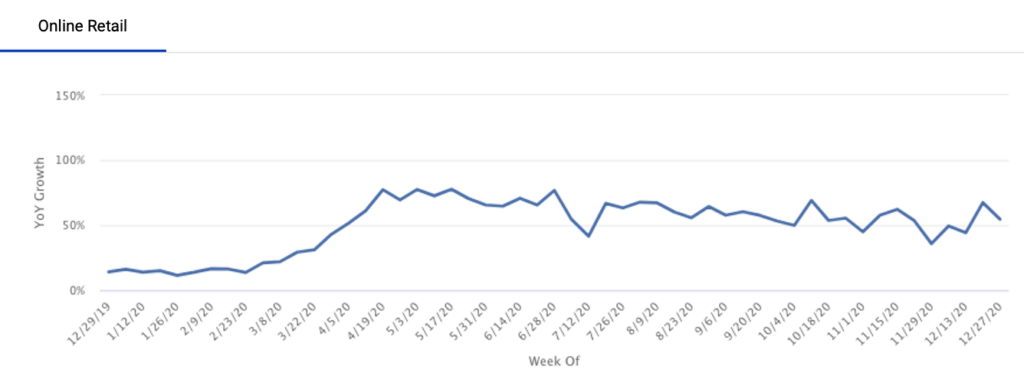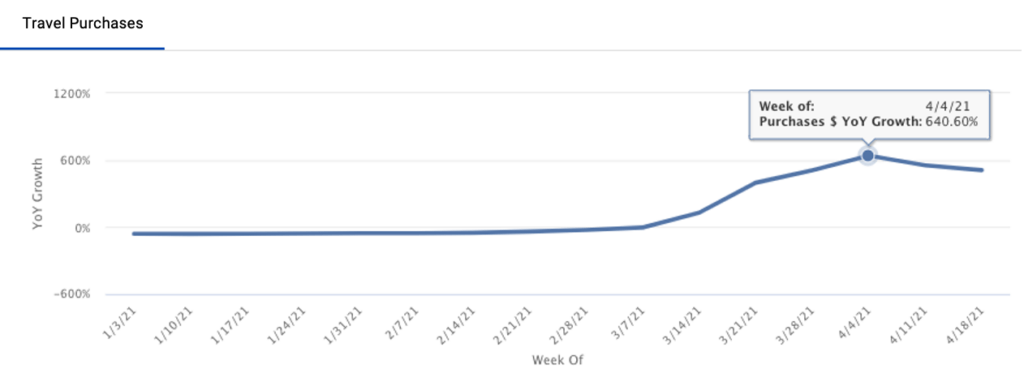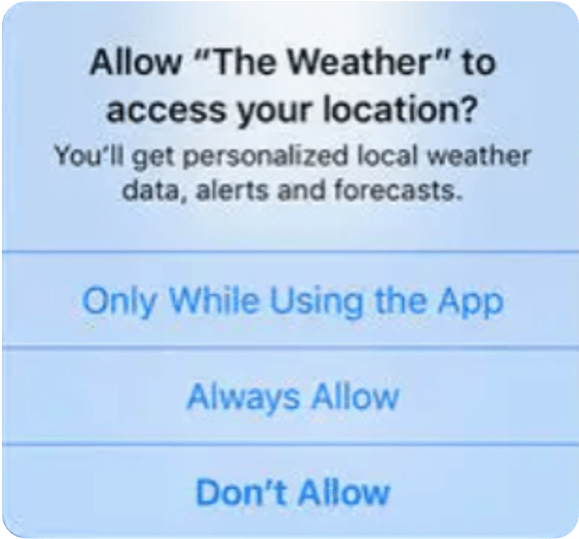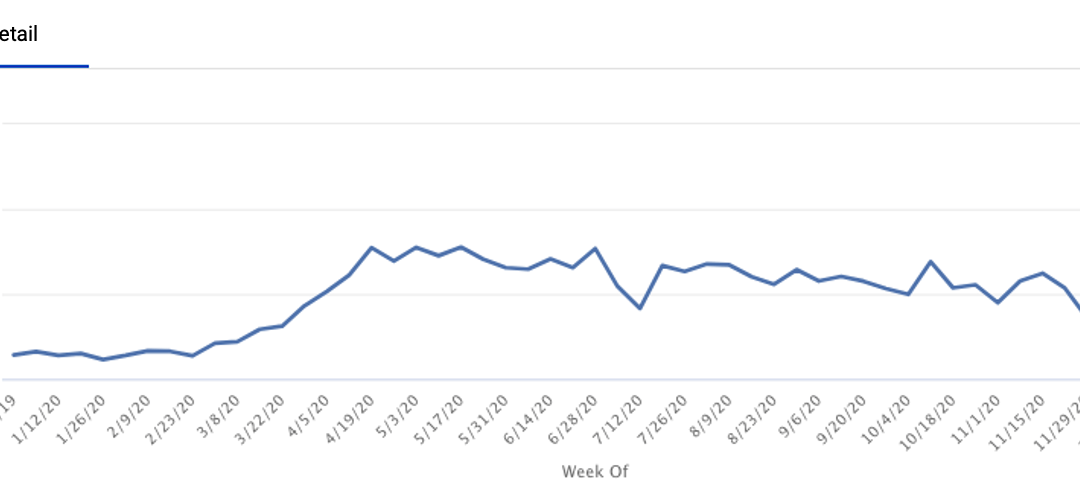The decade from 2010-2019 saw marketers adapt their strategies and tactics to keep up with consumer behavior and technology changes. Smartphone adoption quadrupled from 20% to 85%. Marketers, armed with more data than ever, responded by quintupling their investments in digital ($26B to $151B).
While 2020 was definitely the year of Covid-19, make no mistake, a new decade is well underway. Consumers are no more likely to return to the ways of the 2010’s than they are to return to the ‘80s. Behaviors have permanently shifted. Technology continues to change. Marketers must change as well.
What has changed:
The Pervasiveness of Online Buying
The growth rate of retail online purchases tripled last year, beginning with the start of the pandemic, hovering around 60% from April 2020 onward. As illustrated in this line chart of online retail sales change vs. the previous year, this trend shows no sign of slowing down.

Many verticals far exceeded the average, as illustrated in the below chart. The growth of buy online, pick up in-store (BOPIS) in grocery is well documented, but this behavior change spread well beyond supermarkets. Mass discounter saw tremendous online sales growth. At times their online sales growth outpaced Amazon. Sporting goods, hobby stores, electronics and home retailers also saw an explosion of online sales.
The Continued Shift from Cash to Cards
While credit and debit cards usage has been on the rise for many years, the COVID-19 pandemic has brought about an unprecedented decline in cash purchases. Americans are not only using their cards more but, consumers in general seem to be abandoning cash in favor of credit and debit cards. Our consumer card spending panel across 40 million households showed that retail card spending was up 15.4% in 2020.
While this trend is related to the acceleration is online purchases, it’s more broad-based. Fundera’s Cash vs Credit Card Spending Statistics show that 80% of consumers prefer spending with a card instead of cash. Even when purchasing in stores, the use of “tap and go” card transactions has increased considerably according to a Global Payment Report by FIS.
Despite a free fall in 2020 travel spending of 52.5% (a category which is nearly all purchased on credit and debit cards), card spending was actually up across all categories 0.8%, per Nilson Report. With 2021 travel already picking up vs. the worst weeks of the pandemic (see chart below), the underlying shift to card purchasing is more clear. Card purchases through April 24, 2021 are up a whopping 23.8% across all categories.

Privacy & Technology
While GDPR and CCPA have had some impact on U.S. marketers, by most accounts few consumers actually do opt-out. This smartphone pop-up has had a bigger impact on marketers who became reliant on location data for insights, audiences and measurement over the last decade.
Apple’s iOS 13 made users aware that their apps were tracking them in the background, leading to a nearly 70% reduction in always on location data and correlated decline in accuracy. Now iOS 14.5 brings more tracking related pop-ups that will constrain marketers use of mobile advertising identifiers. And yes, the death of cookies is less than a year away.

Marketing in the 2020’s
With online spend soaring and phone tracking declining, marketers can no longer look to location data or web activity for a robust understanding of consumer behavior.
Anonymized spending on credit and debit cards is the truth set that data driven marketers need for insights, audiences and measurement in this new decade. It includes online and in-store spend and is free from location signal errors and bot traffic. Bots don’t buy. Consumer cards are already the dominant payment method, and they are growing in nearly every category (see chart below).
Importantly, card spending data is privacy compliant. Banking is a highly regulated industry. Individual level, transaction data can never be shared. Card spending products are always anonymized, aggregated or modeled. If consumers don’t want to be included in aggregated or modeled use cases, they can opt out with their bank.
Importance of Context
Card spending data can provide the view into consumer behavior that advertisers need, but as with any data, context is required to avoid incorrect conclusions. Consider a loyal Starbucks buyer, who uses the four different cards in their wallet on different purchase occasions. This loyal shopper would look like an infrequent shopper when only considering one card. Treating a card as a person is misguided and leads to marketing inefficiency.
Commerce Signals, a TransUnion company, is consumer focused, not card focused. Only Commerce Signals unites spending across different cards to a full wallet view. The charts in this article and all our audiences, measurement and insights products leverage this wallet view. As vaccinated consumers change behaviors again in 2021 and beyond, our spending data continues to provide a source of truth for marketers. Contact us to learn more.

